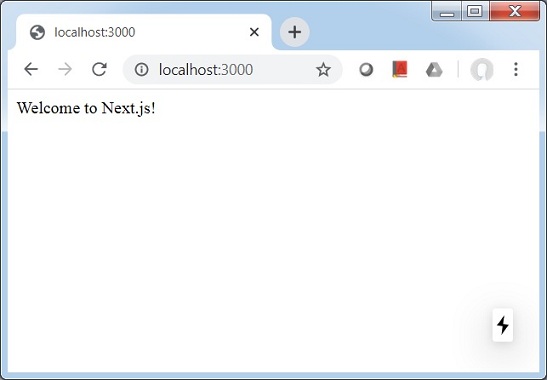
- Next.js Tutorial
- Next.js - Home
- Next.js - Overview
- Next.js - Environment Setup
- Next.js Features
- Next.js - Pages
- Next.js - Static File Serving
- Next.js - Meta Data
- Next.js - CSS Support
- Next.js - Global CSS Support
- Next.js - Pre-Rendering
- Next.js Routing
- Next.js - Routing
- Next.js - Dynanic API Routes
- Next.js - Imperitive Routing
- Next.js - Shallow Routing
- Next.js API Routes
- Next.js - API Routes
- Next.js - API MiddleWares
- Next.js - Response Helpers
- Next.js Miscellaneous
- Next.js - Typescript
- Next.js - Environment Variables
- Next.js - Deployment
- Next.js - CLI
- Next.js Useful Resources
- Next.js - Quick Guide
- Next.js - Useful Resources
- Next.js - Discussion
Next.js - Environment Setup
As Next.js is a react based framework, we are using Node environment. Now make sure you have Node.js and npm installed on your system. You can use the following command to install Next.js −
npm install next react react-dom
You can observe the following output once Next.js is successfully installed −
+ react@16.13.1 + react-dom@16.13.1 + next@9.4.4 added 831 packages from 323 contributors and audited 834 packages in 172.989s
Now, let's create a node package.json −
npm init
Select default values while creating a package.json −
This utility will walk you through creating a package.json file.
It only covers the most common items, and tries to guess sensible defaults.
See `npm help json` for definitive documentation on these fields
and exactly what they do.
Use `npm install <pkg>` afterwards to install a package and
save it as a dependency in the package.json file.
Press ^C at any time to quit.
package name: (nextjs)
version: (1.0.0)
description:
entry point: (index.js)
test command:
git repository:
keywords:
author:
license: (ISC)
About to write to \Node\nextjs\package.json:
{
"name": "nextjs",
"version": "1.0.0",
"description": "",
"main": "index.js",
"dependencies": {
"next": "^9.4.4",
"react": "^16.13.1",
"react-dom": "^16.13.1"
},
"devDependencies": {},
"scripts": {
"test": "echo \"Error: no test specified\" && exit 1"
},
"author": "",
"license": "ISC"
}
Is this OK? (yes)
Now update the scripts section of package.json to include Next.js commands.
{
"name": "nextjs",
"version": "1.0.0",
"description": "",
"main": "index.js",
"dependencies": {
"next": "^9.4.4",
"react": "^16.13.1",
"react-dom": "^16.13.1"
},
"devDependencies": {},
"scripts": {
"test": "echo \"Error: no test specified\" && exit 1",
"dev": "next",
"build": "next build",
"start": "next start"
},
"author": "",
"license": "ISC"
}
Create pages directory.
Create a pages folder within nextjs folder and create an index.js file with following contents.
function HomePage() {
return <div>Welcome to Next.js!</div>
}
export default HomePage
Start Next.js Server
Run the following command to start the server −.
npm run dev > nextjs@1.0.0 dev \Node\nextjs > next ready - started server on http://localhost:3000 event - compiled successfully event - build page: / wait - compiling... event - compiled successfully event - build page: /next/dist/pages/_error wait - compiling... event - compiled successfully
Verify Output
Open localhost:3000 in a browser and you will see the following output.

Advertisements